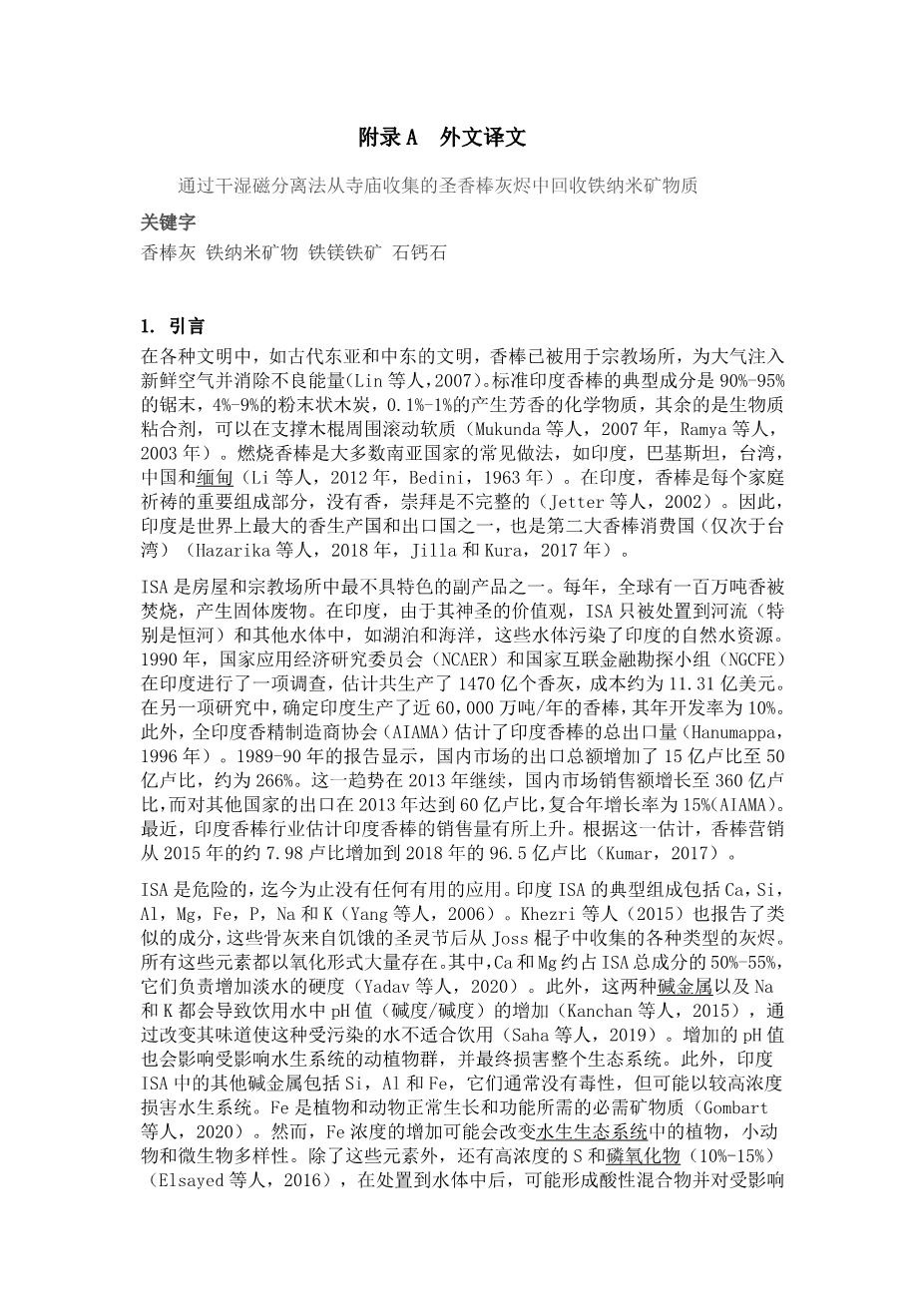Recovery of iron nanominerals from sacred incense sticks ash waste collected from temples by wet and dry magnetic separation method
Abstract
Indian incense stick ash (ISA) contains about 4%–8% ferrous iron (Fe2 ), the fourthhighest metal oxide mineral in ISA, as confirmed by X-ray fluorescence spectroscopy (XRF). The source of ferrous iron fractions in ISA is coal powder, which facilitates the burning of incense sticks. Ferrous iron is separated by two methods — dry and wetslurry magnetic separation. Both are eco-friendly and cost-effective and assume a safe and rapid one-step process. The wet-slurry magnetic separation method is found to be more efficient, as its yield is almost twice the separation and purity level of the dry magnetic separation method. Various techniques have been employed to explore the chemical, physical, and morphological properties of recovered ferrous iron fractions. For example, Fourier transform-infrared spectroscopy (FTIR) and X-ray diffraction (XRD) have elucidated the micro-crystalline nature of the separated particles. Two types of microscopy techniques – field emission scanning electron microscopy (FESEM) and transmission electron microscopy (TEM) – have revealed the surface topography and morphology of the recovered ferrous iron particles, which are spherical and sized between 40 and 120 nm. Additionally, energy-dispersive X-ray spectroscopy (EDS) has confirmed that ferrous iron particles were rich in iron content, as the spectra showed prominent peaks for Fe and O, while the presence of Al, Si, Ca, Na, C, Na, Mg, Mn, and K indicates impurities associated with the samples.
- Introduction
In various civilizations, like those of ancient East Asia and the Middle East, incense sticks have been used in religious places to infuse the atmosphere with fresh air and eliminate bad energy (Lin et al., 2007). The typical composition of standard Indian incense sticks is 90%–95% sawdust, 4%–9% powdered charcoal, 0.1%–1% of an aroma-producing chemical, and the rest is a biomass binder enabling the rolling of the soft mass around a support wooden stick (Mukunda et al., 2007; Ramya et al., 2003). Burning incense sticks is a common practice in most South Asian countries, such as India, Pakistan, Taiwan, China, and Burma (Li et al., 2012; Bedini, 1963). In India, incense sticks are essential components of prayer in every house, without which worship is incomplete (Jetter et al., 2002). As a result, India is one of the largest producers and exporters and the second-largest consumer of incense sticks (after Taiwan) in the world (Hazarika et al., 2018; Jilla and Kura, 2017). ISA is among the most uncharacterized by-products in houses and religious places. Every year, a million tons of incense sticks are burned around the globe, producing solid waste. In India, due to its holy values, ISA is disposed only into rivers (especially the Ganga) and other water bodies, such as lakes and oceans, which pollute Indiarsquo;s natural water resources. In 1990, the National Council of Applied Economic Research (NCAER) and the National Group of Connected Financial Exploration (NGCFE) have performed a survey in India, estimating that a total of 147 billion incense stick ash was produced, with a cost of around 1.131 billion USD. In another study, it was determined that almost 60,000 million tons/annum of incense sticks were manufactured in India, which has an annual developing rate of 10%. Additionally, the All-India Agarbathi Manufacturers Association (AIAMA) has estimated the total export of incense sticks from India (Hanumappa, 1996). The report from 1989–90 shows that the total exports have been enhanced by |1.5 to |5 billion in the domestic market, which is around 266%. The trend continued in 2013, with the domestic market sales increasing to | 36 billion, while the export to other countries attained | 6 billion in 2013 with a compounded annual growth rate of 15% (AIAMA). Recently, the Indian incense sticks industry has estimated the rise in the sales of incense sticks in India. According to this estimation, incense sticks marketing increased from approximately |7.98 in 2015 to |9.65 billion in 2018 (Kumar, 2017). ISA is hazardous and does not have any useful application to date. The typical composition of Indian ISA includes Ca, Si, Al, Mg, Fe, P, Na, and K (Yang et al., 2006). A similar composition was also reported by Khezri et al. (2015) from various types of ashes collected from Joss sticks after the Holy Ghost festival in Hungry. All these elements are present in their oxide form in large quantities. Out of these, Ca and Mg comprise about 50%–55% of the total ISA composition, and they are responsible for increasing the hardness of freshwater (Yadav et al., 2020). Moreover, both of these alkali metals, along with Na and K, are responsible for the increase of pH (alkalinity/basicity) in potable water (Kanchan et al., 2015), making this contaminated water unfit for drinking by altering its taste (Saha et al., 2019). The increased pH also affects the flora and fauna of impacted aquatic systems and, ultimately, harms the overall ecological system. Further, other alkali metals in the Indian ISA include Si, Al, and Fe, which are normally not toxic but may harm the aquatic systems in higher concentrations. Fe is an essential mineral, needed by plants and animals for normal growth and functioning (Gombart et al., 2020). However, an increase in Fe concentration may alter plants, small animals, and microbial diversity in the aquatic ecosystem. In addition to these elements, there is a high concentration of S and phosphorus oxides (10%–15%) (Elsayed et al., 2016), that, after disposal into water bodies, may form an acidic mixture and pose a threat to the living organisms within the affected aquatic system (Cabral-Pinto et al., 2020; See and Balasubramanian, 2011). Indian incense sticks use coal powder as a facilitating agent for burning incen
剩余内容已隐藏,支付完成后下载完整资料

英语译文共 30 页,剩余内容已隐藏,支付完成后下载完整资料
资料编号:[590647],资料为PDF文档或Word文档,PDF文档可免费转换为Word
课题毕业论文、文献综述、任务书、外文翻译、程序设计、图纸设计等资料可联系客服协助查找。


